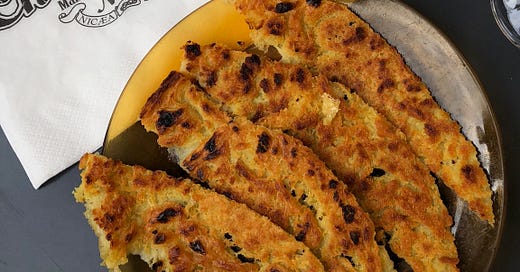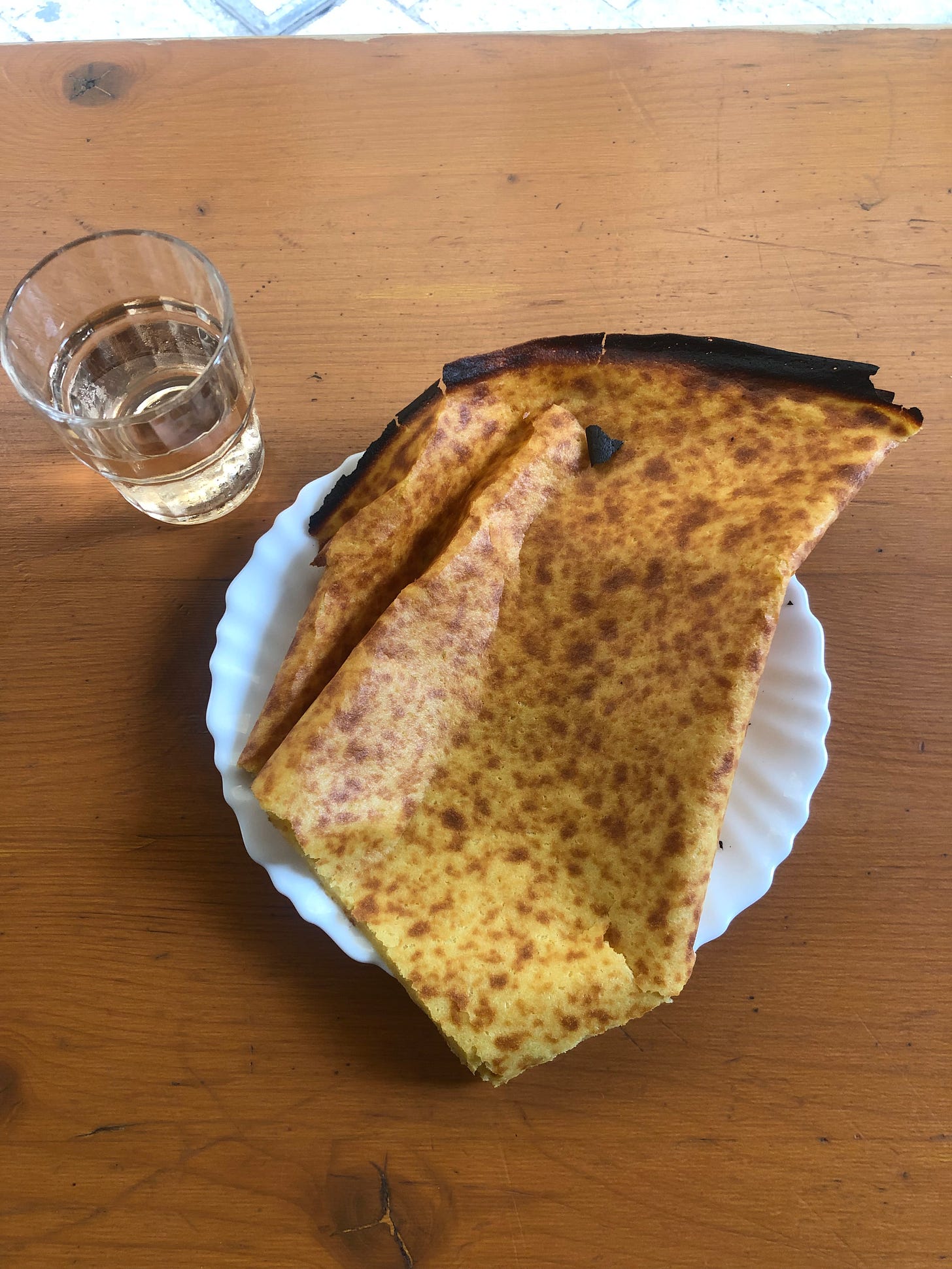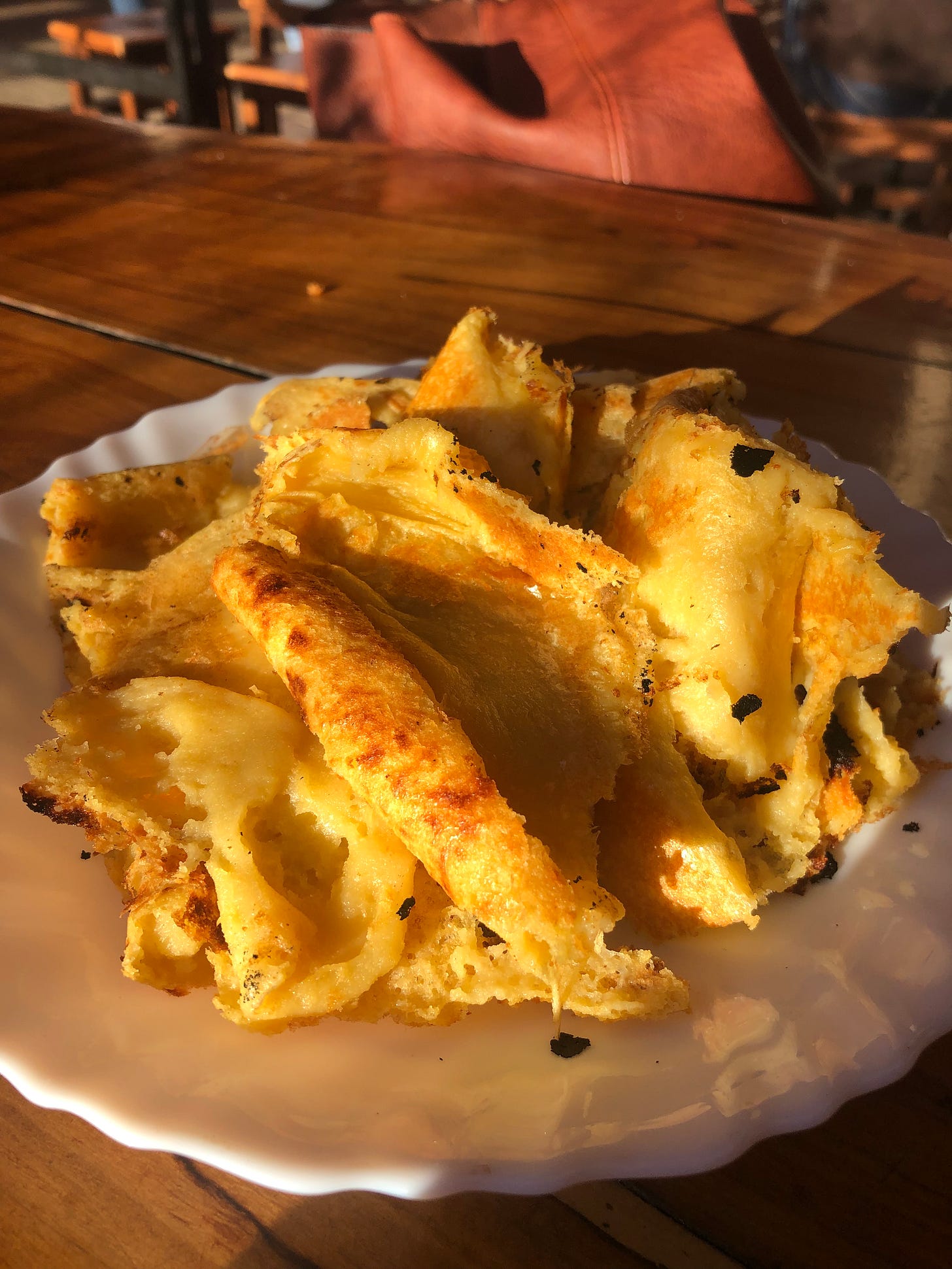Dearest Edible History readers – My apologies for the newsletter hiatus. In between travel, moving into a new apartment and this soupy NYC heatwave, I have been somewhat distracted. But I am back – and with some exciting news: This Friday I’m launching a jewelry collaboration with the supremely talented designer MackBecks! All of the pieces in the limited edition EDIBLE HISTORY X MACKBECKS line are inspired by this very newsletter: The Pineapple, The Oyster and NYC Icons: The Cup of Coffee (with a nod to the Domino Sugar Refinery). The collection goes on sale Friday July 12th at 12pm EST on Mackbecks’ site and can be purchased here.
A couple weeks ago, on an uncharacteristically gray Thursday afternoon in Nice, I sat down for a plate of Socca in the old town. I huddled under the awning of Lou Pilha Leva, avoiding the Sirocco’s sandy droplets of rain that were coating every surface in town in a thin film of dust (the Sirocco wind originates in North Africa and carries dust from the Sahara Desert across the Mediterranean into Southern Europe in the early summer months). I tore off a piece of Socca and chewed. It was bone dry – hitting the back of my throat, and then just kind of staying there. The Socca was bad. This is not how Socca should be.
If you’re unfamiliar with Socca, you’re probably not alone. Only once have I ever seen Socca on a menu outside of Nice (RIP Pates Et Traditions, a real pandemic loss). Though if you have traveled to the southern French city – you’ve likely tried it. Socca is a classic niçoise dish, made from chickpea flour and cooked in a pizza-like oven. It cooks quickly (this is not Daube) and once removed from the flames, it is roughly cut into large strips and piled on a plate. You tear off pieces with your hands to eat it – no knife and fork. Some Socca establishments put salt and pepper out for customers to use (these are the only condiments allowed on Socca). Other establishments do not. It shouldn’t be too greasy, but it also should not be dry.
Just as New Yorkers have their favorite pizza spots, the Niçois have their favorite Socca spots. Yesterday, via Whatsapp, I polled my family in Nice about where to get the best Socca in town. I received different answers, “none of them wrong” (which is surprising considering this is the same family that I recently witnessed passionately argue about the difference in taste between regional variations of arugula). I guess when it comes to Socca, every Niçois is allowed to have their preference.
There is Chez Pipo on Rue Bavastro, where the strips of Socca always have a good char on them, salt is on the table, and you can watch the world go by as you dine on the sidewalk. Then, there is Socca d’Or on Rue Bonaparte, where the Socca can be a bit oily (I don’t mind this) and you can sit for ages over endless plates of Socca, Pissaladiere and small glasses of crisp white wine.
I’m partial to Chez Rene Socca on Rue Miralheti, right at the entrance to the old town. Here, you can get a sizable plate of Socca for 3.50 euros, and park yourself at one of the picnic tables next to their sister bar across the street. The Socca is crispy, salty, and has just the right amount of oil.
One evening, after a long, lazy and delightful afternoon at the beach, my friend Constance and I wandered over to Rene’s for Socca and some drinks. Constance lives in Nice, and in addition to being a talented graphic designer, also leads food tours through the old town – which means she usually has an in with the guys behind the counter.
We made our way into the kitchen, which is largely open to the street, and contains one of the last wood-fired traditional Socca ovens in Nice. Here, a cook in a Derrick Rose Chicago Bulls jersey was ladling a mixture of chickpea flour and water into a very large, and quite shallow cast iron skillet. Using a whisk, he combined the water and chickpea flour together, and then with a long pole – pushed the whole thing deep into the flames of the oven.
The result? Yellow furls of Socca sitting on a white plastic plate shimmering in the golden hour light. Crispy edges with a slightly squidgy center, little flecks of char scattered on top like a spice from the fire. Tearing off a morsel and chewing it slowly, I was satisfied. As the sun began to set, my cousin joined us. The street was busy with tourists and locals alike. Glasses empty and plates clean, we set off deeper into the winding streets of the old town to find some dinner. Now this, is how Socca should be.
Edible History is a reader supported newsletter. To support my work and to gain access to the full archive of posts (each month paid subscribers receive additional edible histories and recipes in their inbox) consider upgrading to become a paid subscriber.








A very interesting testing review of the different Socca ! Thank you for those nice moments. Can’t wait to share one more with you!
You are really my favorite niçoise. Come back soon please. Your post is very well written. And true. And…….i am an real niçoise.